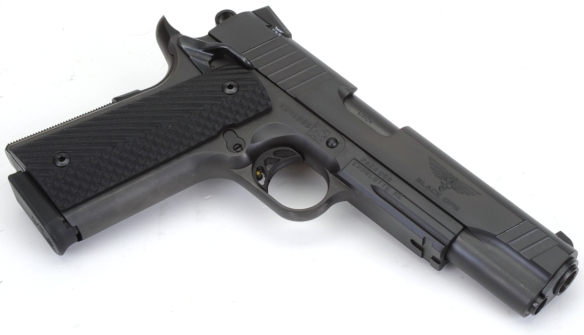
There aren’t a lot of companies that begin life in Canada making paintball guns and end up in a 30,000 square foot facility in North Carolina making 1911 derivatives. However, that is about what Para Ordnance accomplished between 1985 and 2009, with 1988 as the actual transition year from paint ball gun to lead throwing handgun manufacturing. The move from Canada to North Carolina, and Para Ordnance’s name change to Para USA, took place in 2009. In 2012 Para USA hit the marketing and manufacturing resource jackpot when they became part of the Freedom Group. Based on the popularity of Para USA products, and the number of models in prerelease queue, I’d guess their progress hasn’t been an accident… eh?
Departures with tradition
Below, far left, the Black Ops 1911 is an 80 Series type gun with a firing pin plunger, shown next to a 70 Series type firearm without a firing pin plunger. Far right, the Black Ops 1911 has a corresponding firing pin plunger lever that raised the firing pin plunger when the trigger is depressed. If the trigger is not depressed, the plunger remains in place, blocking forward movement of the firing pin to prevent accidental discharge caused by a jolt to the firearm.
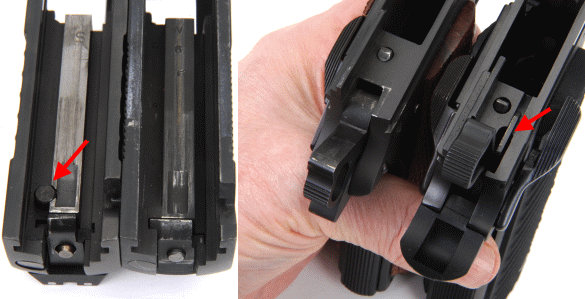
Good, bad or indifferent? Depends who you ask. If you’re a target shooter who is used to shooting 1911’s with an 0.015″ sear engagement and you have the trigger sensitivity of a safe cracker, you’ll feel the linkage moving and the plunger being depressed and it may irk you. I know I hate being irked. But if you are like the other 99.15% other shooters it won’t mean a thing. In some states it is either the firing pin plunger or the gun gets the plunger and does not appear on the approved firearm list.
The old inclined plane trick…
The Para USA Barrel, bottom – bottom, is ramped. The purpose of the ramp may be for several reasons: protecting an aluminum frame, assisting in reliably feeding certain types of bullets and allowing additional chamber support of cartridge cases.

Are ramped barrels useful? I’ve not had a properly prepared non-ramped barrel not feed reliably and I have never has a bulged case even with 45 Super and 460 Rowland conversions. I can also say the same for ramped barrels. However, I have had out of the box non-ramped barrels fail to feed properly and I have not had that occasion with ramped barrels. Who ever is keeping score through all of this can pronounce a winner.
Tall or short
The issue of full length versus stub guide rod is a controversy that fills the void when not debating what is the best cartridge for deer hunting, or what is the best firearm for home defense. Gunsmithing sites attribute full length guide rods with preventing recoil spring kinking, reducing rail wear and improving accuracy… although I have never seen scientific, empirical or anecdotal evidence of the same. In the battle of the guide rods theorists, I come down squarely on the side of ambivalence.
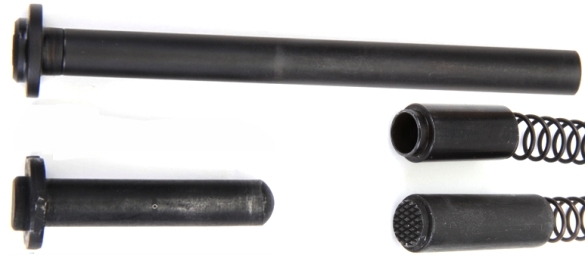
I don’t believe there is enough room around the spring to allow it to kink and I do not think a guide rod that floats at the rear and is located loosely and at shifting points along the rod will have any bearing on rail loading. That said, I can’t see a full length rod doing any harm. The benefit of Para USA’s inclusion of a full length guide rod, as a practical matter, ranges from neutral to good deal. I hear people grousing about disassembly being more difficult. Certainly not in this arrangement.
More long and short of it…
Compared to an early full size GI type 1911, the Para Black Ops has a 0.090″ longer ejector which is consistent with “enhanced” production from other quality manufacturers. The idea is that the ejector is not so long that it prevents the ejection of maximum COL assembled ammo or so short it is at the extreme far end of slide travel and at the lowest point in velocity where lazy ejection can cause jams.
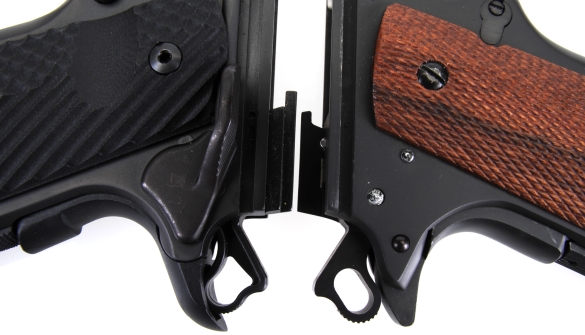
The Para Black Ops dumps most casings 6 – 9 feet from the pistol, dependent upon type of ammunition. By comparison, my early 45 Super conversions spit brass 200 – 300 yards. Getting ejector length and angle and recoil spring rates correct takes some thought. The cast Black Ops hammer is quite a bit lighter than the tool steel Commander hammer on my flogger gun. Lower weight and same springing means reduced lock time and a shot at greater accuracy.
Nice set of snag free Trijicon sights, front and rear. Both dovetail mounted which simplifies adjustment and replacement. The tubes are large enough and bright enough to see.
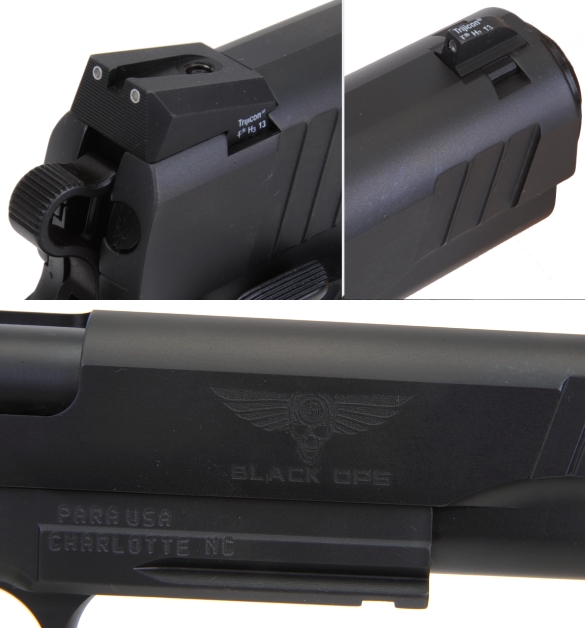
The Black Ops 1911 has an integral accessory rail for mounting laser sights, LED lights and whatever other accessory comes to mind. No, not the bayonet CZ was offering for a while. Bad visual.
Box scores, observations and assessments…
| Manufacturer | Para USA |
| Model | Black Ops 1911 |
| Origin | Charlotte, NC |
| Type Action | Single Action Autoloader |
| Frame & Slide | Stainless Steel |
| Finish | Black IonBond© PVD Finish |
| Grips | VZ® Operator™ Machined G10 |
| Caliber | 45 ACP |
| Capacity | 2×8 Magazine |
| Barrel Length | 5″ |
| Twist | 1:16″ LH |
| Weight – Empty | 42.0 oz |
| Overall Length | 8.75″ |
| Overall Height | 5.6″ |
| Sights | Trijicon Tritium |
| Sight Adjustment | Windage – Dovetail F/R |
| Sight Radius | 6.75″ |
| Trigger Pull | 4 lbs 5 oz |
| MSRP | $1,257 |
| Discount Retail | $1,100 |
| Supplied With | Hard Case, 2 Magazines, gun lock, and manuals |
While listed as such, the Black Ops 1911 Model doe not have a checkered front strap, however, it does have a checkered mainspring housing. Other versions of the Black Ops do have a checkered front strap. It does have a lightweight trigger and it does have a wide Evolution Works extractor. Slide serrations front and rear that provide an excellent gripping surface, without cheese grating the skin from hands. A raised pad on the grip safety assures disengagement and helps to properly position the shooters hand. There is a flat on the slide that runs between front and rear sight. It isn’t bead blasted or stippled to kill reflection, however, it does look good as opposed to a radiused receiver top.
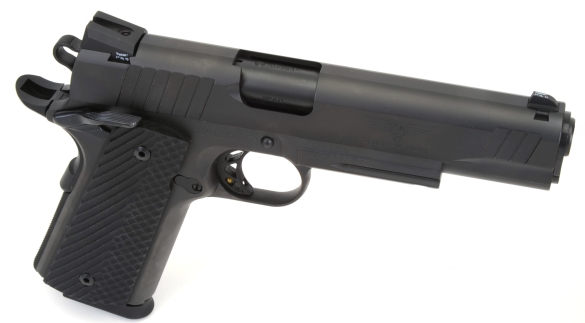
The IonBond© PVD Finish is a hard metal vacuum deposition process, not an epoxy paint. As reminded enthusiastically by readers – Para USA’s “Expert” entry level model was finished in Para Kote early on in production, which apparently didn’t hold up to holster wear and other forms of abrasion. That issue in the “Expert” model was corrected with a switch to a black nitride chemical finish and the higher end Black Ops has always has a completely different and very durable finish. Small control parts like the ambidextrous safety and slide stop, recoils spring plug and, maybe, the barrel bushing appear to have a traditional and durable black oxide finish.
I wish that the Para-USA website would add more spec substance for each model. As an example, listings don’t indicate firearm weight or rifling twist rates and in an attempt to cover several variations within a product type, some boiler plate is incorrect in regard to specific models. I’d hate to see the firearms’ industry fall into NASCAR celebrity marketing where the fact that there are races and actual race cars seems to have been lost in the effort.
Out of the box? Tight slide, stiff operation and a little bit of grit in the trigger. Next step is to conduct live fire assessment and see what the pistol feels like afterward. Sometimes the conditions noted go away after a few rounds are pushed through a firearm.
Para USA’s Black Ops 1911 Part 1
Para USA’s Black Ops 1911 Part 2

Email Notification